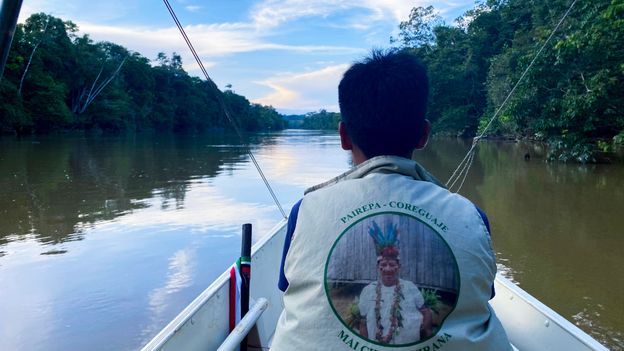‘In the Amazon, protection is spiritual’: Defying coca lords and loggers in the Amazon – BBC

Report on Indigenous Stewardship and its Alignment with Sustainable Development Goals
Contribution to SDG 13 (Climate Action) and SDG 15 (Life on Land)
Scientific studies indicate that indigenous territories within the Amazon demonstrate superior conservation outcomes, with significantly lower rates of deforestation compared to surrounding lands. This effective stewardship is critical for advancing global environmental targets.
- Climate Action (SDG 13): The constant patrols and presence of indigenous guards are instrumental in preserving the Amazon’s role as a vital carbon sink, directly combating the effects of climate change by mitigating forest loss.
- Life on Land (SDG 15): By actively protecting their territories, indigenous communities safeguard terrestrial ecosystems and halt biodiversity loss. Conservation pacts specifically protect fauna, such as tapirs and deer, from poaching and ensure the health of fish populations.
Indigenous Governance and its Impact on SDG 16 (Peace, Justice and Strong Institutions)
The model of indigenous guardianship provides a framework for effective, localized governance that surpasses traditional state-led enforcement in consistency and permanence.
- Effective Institutions: The Indigenous Guard, referred to in the Inga language as wasikama (“guardian of the home”), functions as a strong, community-based institution. Unlike intermittent patrols by public security forces, the constant presence of indigenous peoples ensures sustained protection.
- Community-Led Justice: This system represents a form of self-governance that is deeply integrated with the community, ensuring the protection of their ancestral lands and natural resources.
Capacity Building and Partnerships for SDG 17 (Partnerships for the Goals) and SDG 6 (Clean Water and Sanitation)
Indigenous communities are actively building capacity and forging strategic partnerships to enhance their conservation efforts, reflecting a commitment to collaborative action.
- Knowledge Transfer: Indigenous leaders engage in cross-border training initiatives, sharing expertise in areas such as first aid, river rescue, disaster response, and fire prevention with communities in neighboring countries, including Peru and Ecuador.
- Inter-Community Pacts: Conservation agreements are established between different indigenous groups. For instance, communities along the Putumayo River have formed a pact where upstream groups commit to keeping the waters clean, directly supporting SDG 6 (Clean Water and Sanitation), while downstream communities protect aquatic life.
- Regional Collaboration (SDG 17): These alliances demonstrate a powerful model of partnership, where local communities collaborate across regions to achieve shared environmental and sustainable development objectives.
Analysis of Sustainable Development Goals in the Article
1. Which SDGs are addressed or connected to the issues highlighted in the article?
- SDG 15: Life on Land – The core theme of the article is the protection of the Amazon rainforest, a terrestrial ecosystem. It discusses efforts to combat deforestation and conserve biodiversity, which are central to this goal.
- SDG 13: Climate Action – The article explicitly links the protection of the Amazon to climate change, describing the rainforest as one of the “planet’s greatest carbon sinks” and noting that this function is imperiled as the “planet heats up.”
- SDG 16: Peace, Justice and Strong Institutions – The article highlights the role of indigenous peoples and their governance structures (the Indigenous Guard) in protecting their territories. This relates to ensuring inclusive and participatory decision-making for sustainable development.
- SDG 6: Clean Water and Sanitation – The conservation pacts mentioned in the article include an agreement by upstream communities to “keep the waters clean,” directly addressing the protection of water-related ecosystems.
- SDG 17: Partnerships for the Goals – The article describes how indigenous guards forge “conservation pacts with their peers across regions” and travel to other communities to share knowledge, which exemplifies partnerships for sustainable development.
2. What specific targets under those SDGs can be identified based on the article’s content?
SDG 15: Life on Land
- Target 15.1: Ensure the conservation, restoration and sustainable use of terrestrial and inland freshwater ecosystems and their services, in particular forests. The entire article focuses on the conservation of the Amazon rainforest by indigenous peoples.
- Target 15.2: Promote the implementation of sustainable management of all types of forests, halt deforestation. The article states that studies show indigenous territories “suffer less deforestation” due to the stewardship of their inhabitants.
- Target 15.5: Take urgent and significant action to reduce the degradation of natural habitats, halt the loss of biodiversity. The conservation pacts mentioned include safeguarding animals like “tapirs and deer from poaching.”
SDG 13: Climate Action
- Target 13.2: Integrate climate change measures into national policies, strategies and planning. The efforts of the indigenous guards to preserve the Amazon’s role as a “carbon sink” represent a crucial, localized climate change mitigation strategy.
- Target 13.3: Improve education, awareness-raising and human and institutional capacity on climate change mitigation, adaptation, impact reduction and early warning. The training of guards in “disaster response and fire prevention” directly builds institutional and human capacity for climate adaptation and impact reduction.
SDG 16: Peace, Justice and Strong Institutions
- Target 16.7: Ensure responsive, inclusive, participatory and representative decision-making at all levels. The article describes the Indigenous Guard as a community-led institution whose “presence is constant” and effective, demonstrating a successful model of participatory governance in conservation.
SDG 6: Clean Water and Sanitation
- Target 6.6: Protect and restore water-related ecosystems, including mountains, forests, wetlands, rivers, aquifers and lakes. The agreement among communities along the Putumayo river for upstream groups to “keep the waters clean” is a direct action to protect a river ecosystem.
SDG 17: Partnerships for the Goals
- Target 17.16: Enhance the global partnership for sustainable development, complemented by multi-stakeholder partnerships that mobilize and share knowledge. The article mentions that the guard coordinator has “travelled to other communities in Peru and Ecuador to teach” skills, representing a partnership for knowledge sharing.
3. Are there any indicators mentioned or implied in the article that can be used to measure progress towards the identified targets?
SDG 15: Life on Land
- Indicator 15.2.1 (Progress towards sustainable forest management): The article implies this indicator by stating that studies show indigenous territories “suffer less deforestation and remain better conserved than surrounding lands.” The rate of deforestation is a direct measure of progress.
- Indicator related to 15.5 (Biodiversity): The article implies an indicator through the goal of “safeguard[ing] the fish swimming upriver and protect[ing] animals like tapirs and deer from poaching.” The population trends of these species could be used as a measure of success.
SDG 13: Climate Action
- Indicator related to 13.2 (Carbon Sequestration): The article refers to the Amazon’s role as a “carbon sink.” The amount of carbon stored or sequestered by the protected forest areas is an implied indicator of the effectiveness of these conservation efforts.
SDG 6: Clean Water and Sanitation
- Indicator related to 6.6 (Water Quality): The agreement to “keep the waters clean” implies that water quality parameters (e.g., levels of pollutants, turbidity) in the Putumayo river could be used as an indicator to measure the success of the conservation pact.
SDG 17: Partnerships for the Goals
- Indicator related to 17.16 (Knowledge Sharing): The number of guards trained and the number of inter-community “conservation pacts” forged are implied indicators of the strength and reach of these partnerships.
4. Summary Table of SDGs, Targets, and Indicators
| SDGs | Targets | Indicators (Mentioned or Implied in the Article) |
|---|---|---|
| SDG 15: Life on Land |
15.2: Halt deforestation. 15.5: Halt the loss of biodiversity. |
Rate of deforestation in indigenous territories compared to surrounding lands. Population trends of protected species (e.g., tapirs, deer). |
| SDG 13: Climate Action |
13.2: Integrate climate change measures into policies and planning. 13.3: Improve education and institutional capacity on climate change mitigation and adaptation. |
Amount of carbon sequestered by the conserved forest. Number of guards trained in fire prevention and disaster response. |
| SDG 16: Peace, Justice and Strong Institutions | 16.7: Ensure responsive, inclusive, participatory and representative decision-making. | Effectiveness of the Indigenous Guard’s constant presence in protecting territory (qualitative indicator). |
| SDG 6: Clean Water and Sanitation | 6.6: Protect and restore water-related ecosystems. | Water quality measurements in the Putumayo river. |
| SDG 17: Partnerships for the Goals | 17.16: Enhance partnerships that mobilize and share knowledge. |
Number of inter-community conservation pacts established. Number of guards trained across different communities/regions. |
Source: bbc.com
What is Your Reaction?
 Like
0
Like
0
 Dislike
0
Dislike
0
 Love
0
Love
0
 Funny
0
Funny
0
 Angry
0
Angry
0
 Sad
0
Sad
0
 Wow
0
Wow
0
















































:focal(1500,1000)/https://media.globalcitizen.org/a6/9a/a69a4720-d8a1-4715-b596-18738d03c05c/rotary_polio_hero_image.jpg?#)







/countries/sri-lanka/photo-credit---dmc-sri-lanka.tmb-1200v.jpg?sfvrsn=dc298bcc_1#)



















